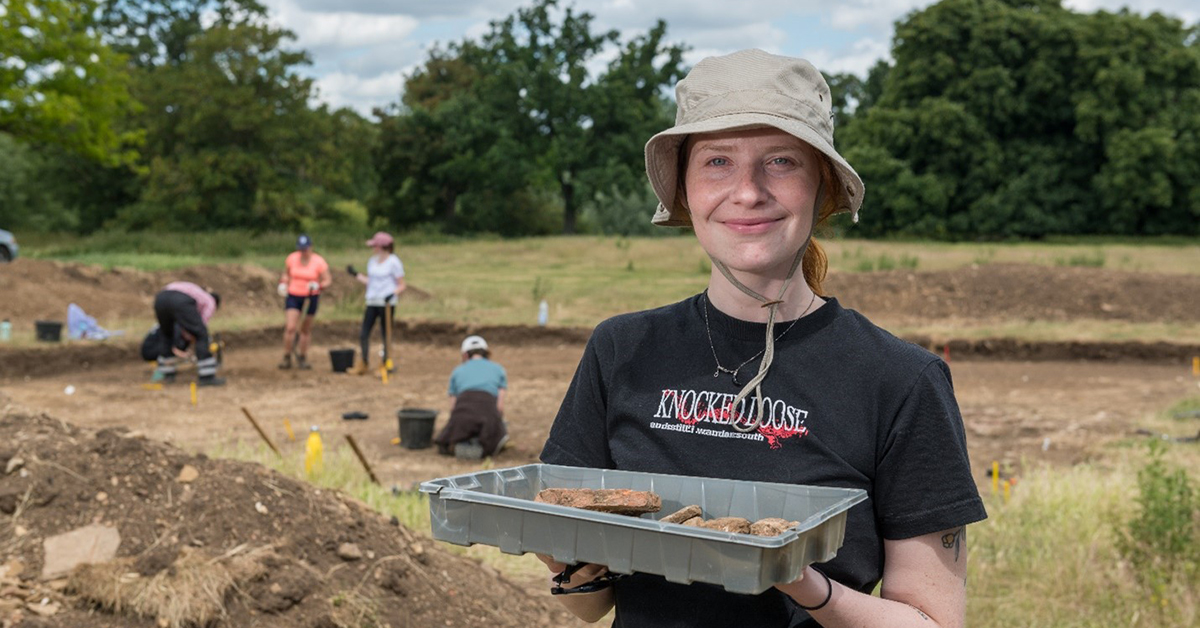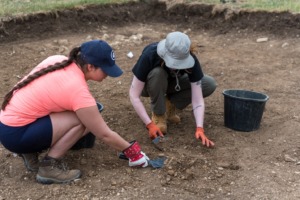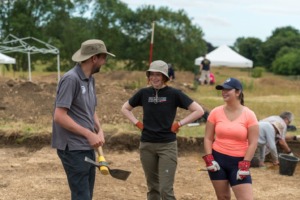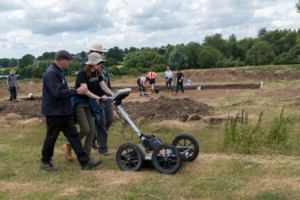My first time on a camping archaeological dig
03/10/2022

Hannah Kloster, current Forensic Archaeology and Anthropology MSc student, talks about her experiences on a recent archaeological dig with Cranfield Forensic Institute (CFI).
Was it your first time on such a dig?
This was my first time doing a week-long camping archaeological dig! I was excited to finally have some real experience in this setting, along with some of the close friends I had made throughout my journey at Cranfield. I was hesitant about the camping aspect, but over the week, you settle in and get to know your surroundings and the people you are with even more.
How did you prepare?
I knew that we were going to be camping, so several trips to the shops were made to stock up on non-perishables and those giant 5-litre jugs of water! My friends and I ended up pooling many resources and sharing things like camp stoves, tents, chairs, and other camping essentials.
Regarding clothes, it was necessary to pack for all weather due to England’s ever-changing climate! It was undoubtedly hot in the sun during the day but surprisingly cold in the evenings. So, layering was crucial. Also, a good pair of either hiking boots or safety boots were needed for a dig (plus waterproof clothing!). And we couldn’t forget sunscreen, sunglasses, and a good bucket hat!

Be prepared and have the right equipment: boots and a hat are crucial.
What were the challenges?
I think the biggest challenge, in the beginning, was trying to determine what it was that we were seeing. There were two trenches. The first trench had already been worked on from a previous year, and features were a lot more visible, but the second was just emerging. As someone with little to no experience with Roman architecture, it was difficult for me to decipher important artifacts/features/building material from, let’s say, just your everyday stones or rubble. However, we were able to work and learn from experienced lead archaeologists on site who helped us through this learning process. From the start of the week to the end, I was confident enough to identify features that I wouldn’t have previously.
Physical fitness is also a challenge because this requires you to be on your feet and move your body for long hours. I can confidently say I discovered muscles I never had before.

Learning from experienced archaeologists.
What did you learn?
I came to Cranfield with the idea of only wanting to pursue a future in forensics, but after doing this module and learning about these types of archaeological digs, I would love to do more. I learned that no matter what your experience is or where you are, if you enjoy what you are doing and who you are doing it with, you can get far.
I gained essential knowledge of the theoretical excavation techniques required for archaeology and how to record material that is discovered which will help me in my future. I also learned that digging up the past really helps us understand more about the individuals who lived during this time, their culture, history, and their lives. Being able to unearth critical pieces that show evidence of the past is something that excites me, and I know I want to keep doing it.
How did it tie in with your courses at Cranfield?
This module was certainly different since it focused on a conventional archaeological excavation, but I think it is highly important for anyone interested in this field. The skills and knowledge we learned from our previous courses were applied to this dig, such as understanding the various soil properties and compositions, stratigraphy and Harris Matrix, context recording, and surveying (plus many more).
This module gave me an insight into another side of archaeology, and I am so happy I could be a part of it. I am now doing my thesis project on analysing the Roman-painted plaster that was excavated from the site…
…so stay tuned!

Using ground-penetrating radar to see what is below the surface.
What did you enjoy the most?
Being able to do ground-penetrating radar was one of my highlights of the week. It has always been something I was interested in learning more about, and thanks to Peter Masters, I could confidently use the GPR and really understand what I was looking at.
My experience was also what I enjoyed most. I want to thank Dave Errickson for helping all of us expand on our archaeological knowledge and practical skills throughout the week. He is incredible to learn from and knows exactly what to look for. He always makes it a point to show us the finds and keeps us updated as the dig is going on. For a module that welcomes individuals with all kinds of experience and all backgrounds, I couldn’t think of anyone better to learn from than Dave. I hope to come back next year as a volunteer, so I can continue seeing this site’s progress!
Categories & Tags:
Leave a comment on this post:
You might also like…
Preparing your work for Turnitin submission
Before submitting your work into Turnitin for similarity checking, if you have used referencing software then you may need to take some important steps first. Mendeley and Zotero integrate with MS Word by embedding field ...
The fast track to supercar engineering: My Cranfield journey
It’s been a dream come true to work on some of the world’s most prestigious supercars – the Aston Martin Valhalla, McLaren 750 & Artura, the GMA T.33. But every successful ...
Automotive Engineering: From student to hypercar innovation at Rimac
We sat down with recent graduate Thomas Perrin, to discuss how his year on the MSc in Automotive Engineering at Cranfield University propelled him from the lecture hall directly into the ...
What this year at Cranfield really meant to me
Every Cranfield journey is unique. In this alumni reflection, Zachea Scicluna shares what her year at Cranfield truly meant, from facing uncertainty to gaining hands-on experience in industry-backed projects. I’ve been reflecting (and delaying) ...
Preparing for assignments and exams?
Sorry! We know it seems a bit mean to mention the exams in January rather than looking forward to the break before it! However, we know many of you will be thinking about your forthcoming ...
Screening for FTSE 100 companies on Bloomberg
So you’re researching an index and need some data on its constituent companies? Bloomberg’s Equity Screening tool makes light work of this, not just for the FTSE, but for indices, exchanges and sectors worldwide. Type EQS ...






